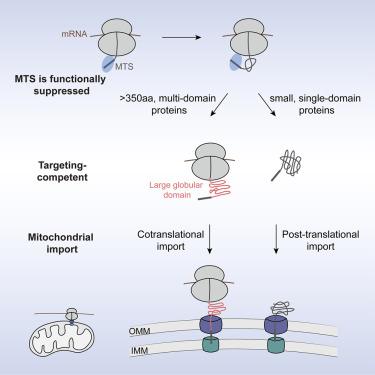共译线粒体蛋白输入的原理
IF 42.5
1区 生物学
Q1 BIOCHEMISTRY & MOLECULAR BIOLOGY
引用次数: 0
摘要
几乎所有的线粒体蛋白都在细胞质核糖体上翻译。这些蛋白质随后是如何被运送到线粒体的,目前还不清楚。使用选择性核糖体分析,我们发现近20%的线粒体蛋白可以在人类细胞中共翻译导入。共翻译输入需要新生蛋白上的n端序列,并有助于线粒体表面的局部翻译。该途径不支持膜蛋白,而是优先考虑大的、多结构域的、拓扑复杂的蛋白质,当共翻译靶向时,其输入效率提高。与协同翻译蛋白靶向内质网(ER)的早期发作相反,线粒体蛋白上的前序在翻译过程中被抑制,直到一个大的球状结构域从核糖体中出现才开始靶向。我们的研究结果揭示了一种多层蛋白分选策略,该策略控制线粒体蛋白靶向的时间和特异性。本文章由计算机程序翻译,如有差异,请以英文原文为准。

Principles of cotranslational mitochondrial protein import
Nearly all mitochondrial proteins are translated on cytosolic ribosomes. How these proteins are subsequently delivered to mitochondria remains poorly understood. Using selective ribosome profiling, we show that nearly 20% of mitochondrial proteins can be imported cotranslationally in human cells. Cotranslational import requires an N-terminal presequence on the nascent protein and contributes to localized translation at the mitochondrial surface. This pathway does not favor membrane proteins but instead prioritizes large, multi-domain, topologically complex proteins, whose import efficiency is enhanced when targeted cotranslationally. In contrast to the early onset of cotranslational protein targeting to the endoplasmic reticulum (ER), the presequence on mitochondrial proteins is inhibited from initiating targeting early during translation until a large globular domain emerges from the ribosome. Our findings reveal a multi-layered protein sorting strategy that controls the timing and specificity of mitochondrial protein targeting.
求助全文
通过发布文献求助,成功后即可免费获取论文全文。
去求助
来源期刊

Cell
生物-生化与分子生物学
CiteScore
110.00
自引率
0.80%
发文量
396
审稿时长
2 months
期刊介绍:
Cells is an international, peer-reviewed, open access journal that focuses on cell biology, molecular biology, and biophysics. It is affiliated with several societies, including the Spanish Society for Biochemistry and Molecular Biology (SEBBM), Nordic Autophagy Society (NAS), Spanish Society of Hematology and Hemotherapy (SEHH), and Society for Regenerative Medicine (Russian Federation) (RPO).
The journal publishes research findings of significant importance in various areas of experimental biology, such as cell biology, molecular biology, neuroscience, immunology, virology, microbiology, cancer, human genetics, systems biology, signaling, and disease mechanisms and therapeutics. The primary criterion for considering papers is whether the results contribute to significant conceptual advances or raise thought-provoking questions and hypotheses related to interesting and important biological inquiries.
In addition to primary research articles presented in four formats, Cells also features review and opinion articles in its "leading edge" section, discussing recent research advancements and topics of interest to its wide readership.
 求助内容:
求助内容: 应助结果提醒方式:
应助结果提醒方式:


